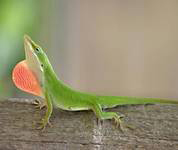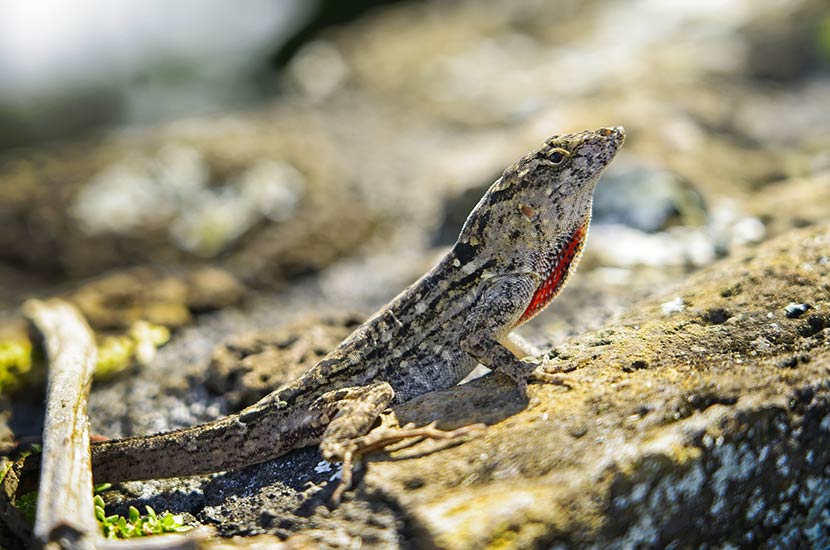Natural History
Also known at the Carolina anole, the American anole, the Red Throated anole, and the American Chameleon, this lizard has become popular pet in the United States. Native to the south east United States, this diurnal lizard is commonly found scurrying across the ground and climbing garden walls, plants, and latticework (no higher than 15 inches high typically). Most of the anoles found in the pet trade are still wild caught but captive breeding has been done successfully.


Description
Although Green anoles are not chameleons, they are frequently called chameleons due to their ability to change from green to brown rapidly especially under stress. These 8 inch lizards are more of a visual pet rather than a handle-able one. Their small stature, visually appealing green coloration, and relatively short life span of 2-4 years makes anoles an ideal pet for many apartment residents. Male anoles are generally a bit larger and display their characteristic ruby red dewlap (a flap of skin that extends primarily during mating season under the throat). This species is capable of autonomy (“tail dropping”) when frightened to distract potential predators.
Enclosure
Green anoles are easily maintained in 10-gallon glass aquariums or other enclosures of a similar size. Screen tops are a must for this species to ensure adequate ventilation. Two anoles can be kept in a 10-gallon enclosure so long as both anoles are female or one is male. Two males will fight and stress each other out. A 20-gallon tank can comfortably house 3-4 anoles.
Full screen enclosures created for chameleons is an excellent option for this species. The larger the enclosure the better with a 2’x2’x2’ screen enclosure being ideal for companion Green anoles. Other options for enclosures include sweater box style containers that can be modified for ventilation, heating, and lighting. These reptiles are not truly arboreal. Anoles are predominantly terrestrial with an excellent climbing ability which should be taken into consideration during enclosure selection.
Cage Accessories
A naturalistic terrarium can be created for the Green anole using live potted plants such as Sansevierias, orchids, and bromeliads which stay relatively small. Fake plants can be used safely and give the same effect as natural plants but do not create humid environment. Potted plants should always be herbicide and insecticide free in case of accidental ingestion of the plant or soil by the reptile. Plants are not only aesthetically pleasing to owners but offers enrichment and security for the anoles in the enclosure. It is ideal to supply as much shrubbery and foliage as possible.
Hides in the forms of rocks caves (not heat caves), small cork logs, and other creative locations should be placed in at least two locations in the enclosure. Preferably, one hide area should be provided on the warm end and one on the cooler end to promote thermoregulation with minimal stress on the animal.
Branches, bark, and some small rocks can be should be added to the enclosure for climbing and basking purposes. Anoles are naturally found running along stone fences and climbing small wooden branches of bushes in the garden. Green anoles enjoy basking in the sun making it a necessity for there to be a branch closer to the basking light for normal behavior.
A water dish is invaluable to increasing the humidity in the Green anoles enclosure. Ideally, the water dish should be shallow enough for the lizard to walk in without submerging itself but deep enough that the water comes up to their shoulders for soaking. It is recommended to remove the water dish if live crickets are being fed as they tend to gravitate towards the water and drown. Most anoles will not eat deceased prey.
Temperature
Day time temperatures are typically maintained at 77-86 degree Fahrenheit with a basking spot of 90-95 degrees. The basking spot should be situated ideally with a rock over the under tank heater or heat cable and directly underneath the basking light. A branch high enough to rest under the basking spot is appropriate too as long as the reptile has no contact with the lamp itself. Care must be taken to prevent burns from basking lights by elevating the lamp itself off the cage screen. If necessary, a fine wire mesh cage can be created around the lamp area to prevent accidental burns. When using under tank heaters or heat cable to increase the ambient temperature of the enclosure care must be that the animal never contacts the heating element itself or the glass/wire/plastic directly over it. A thermostatically controlled device should always be used. A layer of substrate must be provided over the enclosure floor to prevent burns.
At night, the temperatures can drop as low as 70 degrees Fahrenheit but are best maintained between 70 and 75 degrees. If the ambient temperature in the room the reptile is in drops below 70 degrees it is recommended to utilize the under tank heaters, heat cable, or a ceramic heat emitter (does not give off visible light).
Two thermometers should be utilized to ensure that the proper temperatures are being maintained. The cool end of the enclosure should have the thermometer an inch above the substrate. The thermometer on the warmer end of the enclosure should be at the level of the basking site.
Humidity
The humidity in the Green anole enclosure should be kept at 60-70%. A water dish is an excellent way to keep the humidity up especially when it is placed over an under tank heater. Misting 2-3 times a day can keep the humidity up as well but saran wrap may be needed on a quarter to half the screen lid (if used) to maintain the humidity. Likewise, a full screen enclosure may require saran wrap on one or two sides to prevent excessive drying of the enclosure. A drip system or misting system is excellent for maintaining humidity and allow the anole to drink droplets. Some may learn to use a water dish but offering water droplets on leaves is a great choice.
Lighting
All reptiles benefit from some level of UVB lighting. The best is natural sunlight but most captive reptiles rely on specialized UVB emitting bulbs. Green anoles benefit from a 5.0 UVB bulb that can be found at most local pet stores selling reptile supplies. The UVB light should be on 12 hours a day during the day light portion of the light cycle.
Substrate
Green anoles are primarily terrestrial but they do not burrow or dig. An excellent substrate to use for an anole enclosure would be indoor/outdoor or reptile carpet which is more aesthetically pleasing than newspaper and easier to clean than paper towel. All are excellent choices are although for a hygienic cage set-up. Plants can be potted in top soil only to avoid accidental ingestion of toxic materials.
Feeding
The Green anole is a true insectivore enjoying small roaches (such as Dubias), small silk worms, small meal worms, small crickets, and small red worms (“red wrigglers”). A rule of thumb for feeding anoles is the food item offered should always be live and only half the size of the anoles head. Hatchling and young anoles should be offered 2-3 food items once a day and adults should be offered 2-3 food items every other day. Feeder insects should be appropriately gut loaded by offering them dark leafy greens such as kale or endive and carrots (for added vitamin A) 24-48 hours before feeding to the anole. This method of gut loading helps keep the prey items alive longer. Always remove uneaten food after an hour. A powdered vitamin supplement containing calcium should be used to powder the insects 3 times weekly. A multivitamin powder should be used once weekly in the same fashion.
Sources and Suggested Reading
The Guide to Owning a Green Anole, Ray Hunziker
Lizards (Barron’s Complete Pet Owner’s Manual, Harald Jes
Lizard Care from A to Z, Richard Bartlett

